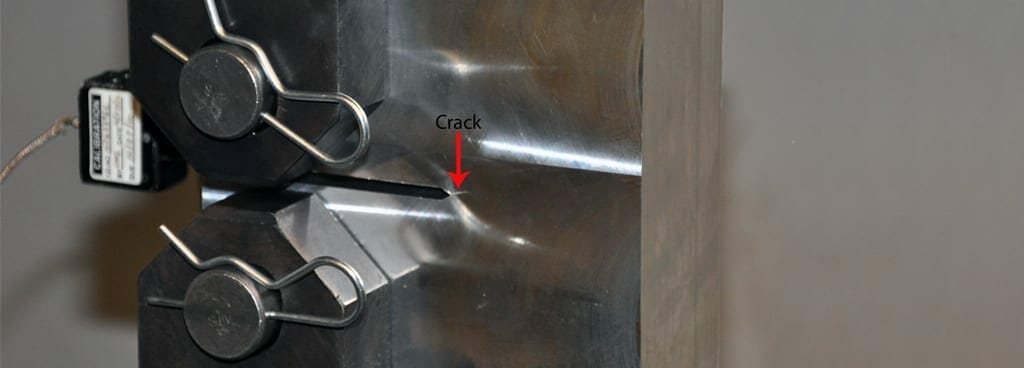- Home
- Services/IndustriesServicesindustries
- About Us
- LocationsStatesAccordion ContentAccordion ContentAccordion ContentAccordion Content
- Job Openings
- Quick Links
- ATS Family

Purpose of CTOD Testing
Applied Technical Services offers CTOD testing for companies who need to determine the suitability of their design materials. Various factors can lead to the initiation of a crack in a structural material, including welding imperfections, stress corrosion, material fatigue, and improper use, to name a few. Once formed, these imperfections propagate to the point of complete fracture if left untreated. Manufacturers and fabricators favor structural materials that display a greater fracture toughness for this reason.
Fracture toughness is a measure of how much resistance a material displays against crack propagation once a flaw (in this case, a crack) has been introduced into its structure. This quality is different from a material’s strength, which indicates how stress the material can support before yield or failure without a flaw present. Verifying a sample’s fracture toughness gives clients insight into how long the material can last between sustaining a crack and succumbing to total fracture — critical time that may afford inspectors opportunity to discover, assess, and respond to the flaw. ATS verifies this characteristic by performing crack tip opening displacement (CTOD) testing.
How the Method Works
Our mechanical testing experts undertake this method by machining a material sample into standardized dimensions. Technicians then introduce a fatigue crack of a specified length by applying calculated, cyclical forces to the sample. Having cut a notch into the center of its mass allows them to control the location and direction of the crack when it forms. Finally, the pre-cracked sample is subjected to static loading to exacerbate the crack until the material fractures. Using the material’s known compliance and a crack mouth opening displacement gage, technicians measure both the length and crack tip opening.
CTOD testing specifically measures the amount that the crack tip opens before the crack progresses. The process yields a measurement of a material’s transition from ductile tearing to cleavage fracture as a function of temperature. As such, ATS testing experts regularly use this method on materials that exhibit this behavior, like ferritic steels. After the sample fractures, they physically measure the actual crack length and calculate validity criteria to determine if the specimen is valid.
As brittle materials cannot arrest the growth of an existing crack as well as can ductile materials, they tend to exhibit lower overall fracture toughness and CTOD values. Differences in fracture toughness may make one material more attractive than another or may disqualify it for an intended use according to industry standards or regulations. ATS’ mechanical testing experts perform CTOD to ASTM E1820 and E1290. Our lab maintains an ISO 17025 accreditation from the A2LA to perform CTOD to these standards.
ATS: A Trusted Mechanical Testing Provider
Since 1967, Applied Technical Services has offered testing, inspection, and consulting engineering capabilities of the highest caliber. In the 50+ years since our founding, we have grown from a fledgling engineering firm helping local businesses out of our founder’s basement into a national, multidisciplinary organization that employs a team of technicians, chemists, inspectors, investigators, and Professional Engineers to serve clients stationed around the world. Industries that can most benefit from ATS’ experience in performing CTOD testing include:
- Aerospace / Aircrafts
- Automotive
- Commercial Properties
- Construction
- Defense / Military
- Healthcare / Medical
- Insurance / Legal
- Manufacturing
- Nuclear
- Oil / Gas
- Power Generation
- Renewable Energy
Quality is Our Policy
Every one of the testing services provided by staff in our Marietta Super Lab is performed in accordance with ATS’ ISO 9001 certified quality management system. This designation means that our quality assurance practices follow the internationally recognized standards that detail effective quality management principles. Abiding by these guidelines helps our organization continually improve the quality of our services.
ATS takes several measures to ensure our customers enjoy a positive experience. Our certified technicians return clear, accurate, and detailed reporting within a short turnaround window so that clients get the results needed to make informed decisions in a timely manner. Furthermore, when our customer service ambassadors receive questions about the status or results of the testing services we provide, they facilitate client contact with relevant testing experts. ATS testing and analysis personnel remain available to client outreach, responsive to their needs, and engaged while helping them pursue a solution to their problems.
If your company needs CTOD testing to verify or determine a design material’s fracture toughness, contact ATS today — We take a closer look!

Request Form
"*" indicates required fields
Mechanical Testing
- Accredited ASTM Lab
- ATSM Brinell Hardness Testing
- ASTM D1002
- ASTM E23 Charpy Impact Test
- ATSM Testing Lab
- ATSM Testing Services
- ASTM F519 Embrittlement Testing Services
- Bend Testing
- Bolt Tension Testing
- Charpy Impact Testing
- Charpy V Notch Testing
- CTOD Testing
- Drop Weight Testing
- Dynamic Tensile Testing
- Elevated Temperature Testing
- Hardness Testing
- High Speed Tensile Testing
- High Temperature Mechanical Testing
- High Temperature Tensile Testing
- Hot Tensile Testing
- Hydrogen Embrittlement Testing
- ISO 6892 Tensile Testing
- Izod Impact Testing
- Lap Shear Testing
- Load Testing
- Load Performance Testing
- Materials Lab Testing Services
- Materials Testing Company
- Mechanical Testing
- Mechanical Testing Certifications
- Mechanical Testing Lab
- Mechanical Testing Services
- Micro Tensile Testing
- Notched Weld Testing
- Plane Strain Fracture Toughness Testing
- Shear Strength Testing
- Shear Testing
- Strain Gauge Testing
- Tensile Coupon Testing
- Tensile Strength Testing
- Tensile Strength Testing Laboratory
- Tensile Testing
- Tensile Testing Lab
- Tensile Testing Metallurgical Lab
- Tensile Testing Metallurgical Laboratory
- Tensile Testing Services
- Torque Testing
- Weld Procedure Qualifications
- Weld Testing
- Weld Testing Services
- WPS Qualified Welding Procedure
